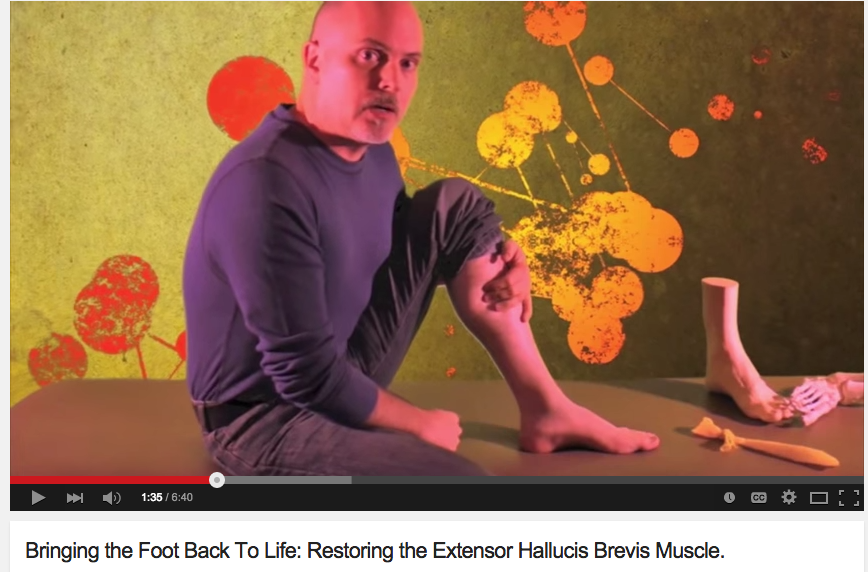Pain at toe-off; Stopping Big Toe Impingement with the extensor hallucis capsularis.
Photo: note the AET coming off the EHL tendon in the diagram
What if there was a mechanism in place by which to pull structures out of the way of a joint moving to end range ? If you know your biomechanics, you know this is a true phenomenon on several levels. We know of one at the knee, the articularis genu has been written about having function of drawing the suprapatellar bursa and joint capsule/synovial tissue cephalad (upward) during knee extension preventing an impingement phenomenon during full quadriceps contraction in knee extension loading.
What if there were a similar mechanism in the big toe ? When teaching we are sometimes asked what joint, that when it goes sour, creates more devastation to the entire biomechanical chain than any other joint. I like to choose the big toe/1st metatarsophalangeal joint because failure to fully push off the big toe at full joint range impairs hip extension, stride and step lengths, and creates compensations far and wide ipsilaterally and contralaterally in the body. Most everyone knows about bunions, turf toe, hallux valgus, sesamoiditis and the like, but there are many other things that can make this joint painful. Today we bring you another “clearing mechanism” that acts to pull synovial and capsular tissues out of a joint that is nearing end range.
As seen in the anatomy dissection photo above, the extensor hallucis capsularis (EHC) is an accessory tendon slip off of the extensor hallucis longus (EHL). Interestingly, one study found that 8% of the dissections showed the EHC came off of the tibialis anterior tendon slip. This EHC accessory slip typically originates off the long extensor tendon (EHL) and traverses medially to the dorsomedial joint capsule region. Some studies suggest it is found in 80-98% of people. We propose it is most likely present in everyone because of the critical nature of its function. We propose that perhaps it may be missed on traditional dissections because of its blending with fascial tissues and because of its sometimes trivial size and girth. Just like when we fully extend our knee we want to be sure the articularis genu will draw the synovial capsular tissue up and out of the patellar/femoral approximation, the EHC has been shown on intra-operative testing to exert a pretension on the metatarsophalangeal (MTP) joint capsule similarly pulling the synovial-capsular tissue free from the end range dorsiflexing toe. Without this function, synovial-capsular impingement can occur and create pain and an inhibitory arthrogenic reflex to the EHL, tibialis anterior or any other muscles around the joint for that matter. This can act and feel like an acute “turf toe” (hyper-dorsiflexion event) and yet, not be true turf toe osseous impingement.
So if your client has pain at the dorsal joint on end range extension of the great toe, meaning things like toe-off, doing push ups from the ball of the foot, jumping, kneeling or squatting with the hallux in forced dorsiflexion etc, this tendon slip (and its origin, the EHL muscle) should be on your mind and assessment of the anterior compartment for S.E.S. must commence (S.E.S.= skill, endurance and strength, our Gait Guys mantra). This is why you need to intimately understand this important video (link) and need to know how to do this exercise, the shuffle walks (video link) and build clean ankle rocker ranges of motion via S.E.S. of the anterior compartment. Pulling on the great toe, twisting it like a radio knob, and forcing end range shouldn’t be the biggest guns in your arsenal, logically restoring all the dysfunctional components should be.
We wonder how many of the videos online of people demonstrating big toe mobilizations, toe distractions, fancy exercises and various toe circus tricks to regain motion and function and reduce pain actually truly know about the anatomy and function of the big toe and how ankle rocker and other things can impair its function. We wonder about these kinds of things.
Please just remember, the average uneducated viewer is merely looking for solutions to their painful parts. Those in the know have a responsibility to deliver as complete a package as possible, within reason.
“With great powers (and knowledge) there must also come, great responsibility.”-Stan Lee
Dr. Shawn Allen
the gait guys
Photo credit link: http://www.wisconsinfootandankleinstitute.com
www.wisconsinfootandankleinstitute.com/img/research/The-Accessory-Extensor-Tendon_fig1.jpg
references:
Foot Ankle Surg. 2014 Sep;20(3):192-4. doi: 10.1016/j.fas.2014.04.001. Epub 2014 Apr 16.
The extensor hallucis capsularis tendon–a prospective study of its occurrence and function.Bayer T1, Kolodziejski N2, Flueckiger G2.
Foot Ankle Int. 2006 Mar;27(3):181-4.
Extensor hallucis capsularis: frequency and identification on MRI.
Boyd N1, Brock H, Meier A, Miller R, Mlady G, Firoozbakhsh K.
Foot Ankle Int. 2004 Jun;25(6):387-90.
The accessory extensor tendon of the first metatarsophalangeal joint.
Bibbo C1, Arangio G, Patel DV.



















